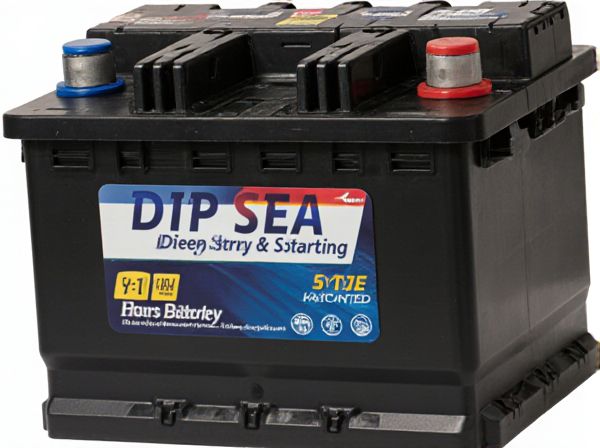
Photo illustration: Deep Cycle vs Starting
Deep cycle batteries provide steady, reliable power over long periods, making them ideal for applications like RVs, solar systems, and marine use. Starting batteries deliver a quick burst of energy necessary to start engines and are not designed for prolonged discharge. Choosing the right battery depends on your power needs and how you plan to use it.
Table of Comparison
| Feature | Deep Cycle Battery | Starting Battery |
|---|---|---|
| Purpose | Provides steady power over long periods | Delivers short bursts of high current for engine start |
| Design | Thicker plates, designed for deep discharge cycles | Thinner plates, optimized for high cranking amps |
| Discharge Depth | Up to 80% depth of discharge | Typically 20% depth of discharge |
| Cycle Life | Higher cycle life (500+ cycles) | Lower cycle life, focused on starting power |
| Main Application | Marine, RV, solar power, electric vehicles | Automotive cars, trucks, motorcycles |
| Cost | Generally higher due to durability and deep cycling | Lower cost, optimized for starting efficiency |
Understanding Deep Cycle and Starting Batteries
Deep cycle batteries are designed to deliver a steady amount of power over long periods and can be deeply discharged repeatedly without damage, making them ideal for applications like solar energy systems and electric vehicles. Starting batteries, also known as cranking batteries, provide a short burst of high current to start engines and are not built for deep discharge, which can reduce their lifespan. Understanding the distinct purposes and construction differences between these battery types ensures optimal performance and longevity in their respective uses.
Key Differences Between Deep Cycle and Starting Batteries
Deep cycle batteries are designed to provide a steady amount of power over an extended period and can be discharged up to 80% without damage, making them ideal for renewable energy systems, golf carts, and marine applications. Starting batteries deliver a high burst of power to start engines and are optimized for short, intense current output, with limited deep discharge capability. The key differences lie in their internal plate construction, capacity for deep discharge, and typical use cases focused on sustained energy delivery versus rapid power bursts.
How Deep Cycle Batteries Work
Deep cycle batteries are designed to provide a steady amount of current over a long period by using thicker lead plates and denser active material to withstand repeated deep discharges. Unlike starting batteries that deliver short bursts of high current for ignition, deep cycle batteries are engineered to discharge up to 80% of their capacity without significant damage. Their construction allows efficient energy storage and slow, consistent release, making them ideal for applications like solar systems, marine use, and electric vehicles.
How Starting Batteries Function
Starting batteries, also known as engine-starting or cranking batteries, function by delivering a high burst of current to power the starter motor of an engine during ignition. These batteries are composed of thin plates and dense active material to ensure rapid energy release but are not designed for deep discharge cycles. Their primary role is short-term, high-current output, making them unsuitable for sustained power delivery or deep cycling applications.
Applications for Deep Cycle Batteries
Deep cycle batteries are designed for sustained energy delivery over extended periods, making them ideal for applications such as solar power systems, electric wheelchairs, and marine vessels. Unlike starting batteries that provide short bursts of high current to start engines, deep cycle batteries excel in powering devices requiring consistent, long-term energy output. Their robust construction supports repeated deep discharges, crucial for renewable energy setups and mobile power storage solutions.
Applications for Starting Batteries
Starting batteries are optimized for providing a high burst of current to ignite engines, making them ideal for automotive, marine, and motorcycle applications where quick engine startup is critical. Unlike deep cycle batteries, starting batteries contain thin plates engineered to deliver rapid energy but not designed for deep discharge or long-term energy supply. Their primary use involves repeated short, high-current bursts rather than sustained power delivery for accessories or electronics.
Performance Comparison: Deep Cycle vs Starting Batteries
Deep cycle batteries are designed to deliver steady power over long periods, offering deep discharge capabilities ideal for applications like solar energy storage and RV use. Starting batteries provide quick bursts of high current to start engines, excelling in delivering immediate power but not suitable for prolonged discharges. Performance comparison highlights deep cycle batteries' durability under repeated deep discharges, whereas starting batteries prioritize high cranking amps and rapid energy delivery.
Lifespan and Maintenance Requirements
Deep cycle batteries typically offer a longer lifespan, often reaching 1,000 to 2,000 charge cycles, due to their ability to be discharged deeply without damage. Starting batteries are designed for short, high-current bursts and usually last around 300 to 500 cycles, as deep discharges significantly reduce their lifespan. Maintenance for deep cycle batteries requires regular equalization and electrolyte level checks, while starting batteries demand less frequent maintenance but cannot tolerate deep discharges without risk of permanent damage.
Choosing the Right Battery for Your Needs
Deep cycle batteries provide sustained power over extended periods, making them ideal for applications like solar systems, RVs, and marine use. Starting batteries deliver short bursts of high current to ignite engines, perfect for cars, trucks, and motorcycles. Selecting the right battery depends on whether consistent energy output or a quick power surge is required for your specific application.
Cost Considerations and Value Analysis
Deep cycle batteries generally have a higher upfront cost compared to starting batteries due to their robust design for sustained energy delivery and longer lifespan. Starting batteries, while less expensive initially, may require more frequent replacement, leading to higher long-term costs in applications demanding continuous power supply. Evaluating cost per cycle and total energy output highlights deep cycle batteries as a more cost-effective value for renewable energy systems, marine applications, and electric vehicles.
 caratoz.com
caratoz.com